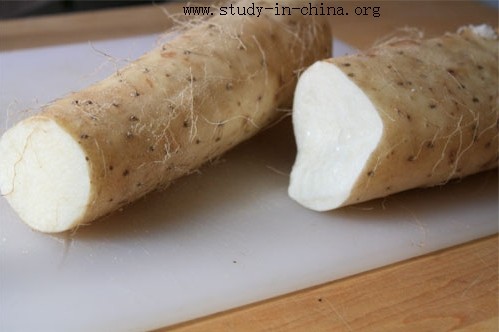more>>More News
Seriously Asian: Naga-imo
By admin on 2015-02-04

You may have seen these long, light-skinned, and
hairy roots at your Japanese or Chinese markets and wondered about their
relation to other kinds of tubers.
Naga-imo is a kind of mountain yam, the
tuberous root of a climbing vine. There are other mountain yams, such as
icho-imo, yamamot-imo, tsukune-imo. Mountain
yams take on a gluey, almost
mucilaginous consistency when they're grated.

But, grating the mountain yam
immediately transforms it from a fairly common-looking root vegetable into a
pile of sloppy white goo. This fact alone makes
naga-imo and other mountain
yams distinct from tubers such as the potato or taro, not to mention the unique
taste and texture.
Mildly sweet like jicama with a texture similar to
taro, only less starchy, naga-imo is delicious pan-fried until the surface is
browned and crisp and the
interior is soft and tender. This is the way I
usually eat naga-imo: after browning some bacon in the cast iron, I use the
bacon fat to cook thin slices of
naga-imo, and call it a day.

But sometimes I'm inclined to go a step further and
take advantage of naga-imo's unique texture. Grated naga-imo is a common
ingredient in Japanese dishes
that require a binder such as okonomiyaki, a
kind of pancake layered with cabbage and often pork belly. I don't often go
through the rigmarole of making
okonomiyaki by shredding cabbage, browning
belly or bacon, sprinkling dashi flakes on top, and dousing the pancake with
kewpie mayoinaise and okonomiyaki
sauce, yet the idea of using grated
naga-imo as a base for a pancake batter is simple enough to do any weeknight.
To prepare the batter, grate the naga-imo with a microplane grater. You
can use a bit of potato starch or rice flour if you want to refrain from dairy,
but
mixing an egg with the grated naga-imo produces just the right
consistency for dropping the batter by dollops into your pan. You can add
anything you want:
chopped bits of bacon, browned garlic and scallions, or
sauteed vegetables. If you happen to have fresh herbs around, like basil, mint,
cilantro, all the
better.

The texture of the batter when it's cooked is
something like the interior of a really tender latke, but with very little fuss.
Serve with a bit of fine
quality soy sauce and sesame oil, and you've got a
naturally gluten-free pancake dish.
Finally, a warning: like taro, the
skin of naga-imo causes mild itching on the skin, so use a pair of gloves when
handling the root.
- Contact Us
-
Tel:
0086-571-88165708
0086-571-88165512E-mail:
admission@cuecc.com
- About Us
- Who We Are What we do Why CUECC How to Apply
- Address
- Study in China TESOL in China
Hangzhou Jiaoyu Science and Technology Co.LTD.
Copyright 2003-2024, All rights reserved





 Chinese
Chinese
 English
English
 Korean
Korean
 Japanese
Japanese
 French
French
 Russian
Russian
 Vietnamese
Vietnamese
